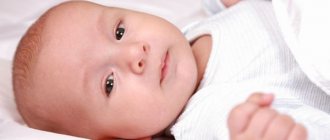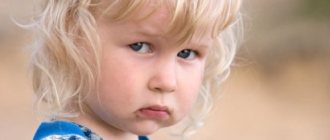Development of a boy and a girl at 1 year old: similarities and differences
Differences between babies (boys and girls) already begin from the first birth, because boys are born larger than girls (they have greater weight and head diameter). Further, parents may notice a number of other differences that can be traced in mental and physiological development.
Here are the most basic ones:
- Girls begin to speak (sounds similar to words and elementary “agu”, “mom” are considered) on average 5 months earlier than boys . Those. at one year old they already know how to express their feelings in simple words and emotions, while boys begin to do this by the age of 1.5 years.
- The same thing happens with walking skills; girls stand on their feet and take their first steps on average 3 months earlier than boys . So, at one year old, girls can already fully move independently over not very long distances, and boys stomp hand in hand with adults.
- Little boys take any criticism very seriously and are very offended when they are scolded or shouted at. Girls are more indifferent, but can be excessively capricious.
- Girls are more sensitive than boys and therefore it can be observed that they are more eager to show their love and feelings to their parents: affection, sharing, frequent kissing.
- At this age (1 year), girls need much less space and toys to keep themselves occupied than boys (which is why boys often explore inaccessible territory).
- Girls get used to the potty faster than boys , and at one year old babies can already relieve themselves when their parents drop them off. In turn, boys often and for a long time resist going to the potty.
- Girls are more drawn to knowledge than boys , and at one year old they are interested in sorting out colored cubes, building elementary figures from construction sets and mosaics, and playing with dolls and cars. Boys love to destroy more than to create.
INTERESTING: Nature intended that women should focus on survival and preservation of the species, while boys should focus on evolution. That’s why it turns out that little girls are calm, domestic, attached to their parents, while boys always strive to learn something and master new things.
Girls and boys at 1 year old
Lag in speech development and its consequences
The mother of a 3-year-old child, who at his age speaks only three light words: “mom,” “baba,” and “dad,” came to me for a telephone consultation. I tried to find out why they decided to seek help so late? Her answer was similar to many other parental phrases that I had already encountered in my practice: “They thought he would speak by the age of three,” “Several neurologists unanimously argued that you just need to wait,” and so on.
The most interesting thing is that mothers intuitively understand that it is time to sound the alarm. But the thoughts “what if it goes away on its own” reduce their determination to nothing. Many people do the same with a visit to the dentist - they put it off until the last minute, until the problem develops from an easily solvable problem into a serious case.
At such moments, parents miss the main thing: “Each age has its own norms and development goals.”
Until the age of three, a child absorbs words into his vocabulary. Then he begins to learn grammar and phonetics. After this, he already learns to talk, write, read, etc. All these skills overlap each other like a layer cake. But if one of the “layers” is missing, then the others will also lag behind. Then there is a risk that the baby will always be caught up.
How much should a 1 year old child eat and drink?
Proper nutrition depends not only on what you feed your child, but also on how many meals he eats per day. Inadequate nutrition can provoke developmental defects in a baby at the age of 1 year, lead to anemia, chronic lethargy and frequent diseases due to a weakened immune system. Excessive nutrition leads to obesity and problems with the pancreas and digestive organs.
The daily nutritional intake for a 1-year-old baby is calculated by experts and provides average units that should be compared to, and not strictly observed. In addition to the norms, you should also pay attention to the needs of the baby, as well as his individual characteristics, because each child is different (some are born large, others small due to genetic predisposition).
Also take into account the baby’s activity; if he is active, he may require more drink and food than a passive and calm child. Another feature of children aged 1 year is metabolism, it is different for everyone. This is why children with a good metabolism grow up thin, and those with a poor metabolism grow up plump.
It is important to know that a one-year-old baby must eat about 1200 meals per day and drink at least 200 ml of liquid. However, take into account the time of year, because in the summer heat children may drink more liquid. At this time, the baby's diet should take on a standard four-course diet, which consists of breakfast, lunch, afternoon snack and dinner. The most high-calorie and largest meal is lunch, other snacks should be less nutritious.
Recommendations for feeding a 1 year old baby:
- The amount of porridge (i.e. one serving) should be 200 grams. You can eat any cereal: buckwheat, rice, millet, barley, wheat.
- White and lean meat is allowed for consumption in the amount of 70 grams.
- You can eat fish every day, but not a lot - 60 grams is enough.
- Vegetables or vegetable puree should also be approximately 200 grams of the daily requirement.
- Fruits and fruit puree – 100-110 gr. per day (any non-exotic fruits).
- Fermented milk products occupy an important place in the baby’s menu, and the permissible amount of fermented baked milk kefir, yogurt or cottage cheese per day is 200 grams.
- There should not be a lot of bread in the diet of a one-year-old baby, because 10 g of white bread is the daily norm.
- Dry, biscuit and lean cookies are allowed in the amount of 15 per day.
- Fruit, berry and vegetable juices can also be included in the diet, but they must be completely natural and should not exceed the permissible amount of 100 ml.
IMPORTANT: The calculation of acceptable foods was based on the fact that at the age of 1 year the baby is still fed milk. So per day, he must consume up to 350 ml of mother’s breast milk or special diluted milk formulas.
Pay attention to the child’s behavior during feeding; if he refuses milk, it means that other food was enough for him and vice versa. If a child refuses a planned lunch or afternoon snack, this indicates that the previous breakfast or lunch was very filling for him.
At the age of 1 year, the baby should have in his diet:
- Potato
- Zucchini
- carrots
- Broccoli
- Beetroot
- Apple
- Banana
- Plum
- Oatmeal
- Buckwheat
- Rice
- Pearl barley
- Jachka
- Beef
- Chicken
- Turkey
- Kefir
- Cottage cheese
- Yogurt
- Ryazhenka
IMPORTANT: Try not to introduce allergenic foods (strawberries, grapes, citrus fruits) into your baby’s diet at this age. All food should be prepared only from fresh and natural products. During feeding, try to instill in your child neatness and the ability to care for himself.
Nutrition for a one-year-old child
What time do children begin to speak their first words?
We can conclude that the answer to the question of what time a baby will start talking is about a year. It is at 12 months that the first words appear. They should not be confused with the babble from which they come. The line between them is not always easy to determine, but still, if you carefully observe the baby, you can catch it.
Such words are very simple; they do not contain a stressed syllable. Typically, children try to identify the most important and familiar things or actions. At the same time, the passive vocabulary accumulates more actively. By the age of one year, some babies can say a couple of words, for example, “mom” or “dad,” others - 10-20, but this all fits into the norm. The main criterion: the child must understand speech addressed to him.
Advice
In order for the baby to speak faster, parents should not rush to fulfill his request if it is accompanied only by gestures or mooing. You need to ask him to express his desire in words.
Active speech is formed spasmodically. In a year, the baby learns only from 1 to 6 words every month. This stage can last quite a long time. Then a leap in development occurs, and the number of new words that the child learns per week increases to 12. After some time, another leap occurs, and the baby remembers about 12 words per day. At this stage, the passive and active vocabularies are equalized, then they are replenished simultaneously.
After one and a half years, children begin to pronounce more and more words correctly, and not in their own language. By age 2, they can string two or more words together. If this does not happen before two and a half years, then it is recommended to contact specialists.
What vitamins does a 1 year old child need?
After a child turns one year old, he enters a new stage of life and becomes much more mature. During this period, his body begins to actively develop:
- Baby teeth grow quickly
- The baby is growing
- It develops vertebrae (vertebral curves)
- The chest expands
- Motor activity increases
- Mental activity improves
- Muscle mass increases
- The digestive system is active
- Pressure is rising
- Improves immune system and protective barrier
- Improves mental and emotional development
IMPORTANT: For the harmonious and healthy development of the child, the baby should eat enough and receive the necessary vitamin complex.
Important vitamins for a one-year-old child:
| What vitamin | Why is it needed? | In what products can you find it? |
| A | Provides the baby with good and sharp vision, helps the skeletal system form, strengthens the immune system and | Any vegetables and fruits that are yellow and orange, as well as any dairy products and eggs |
| IN | A group of these vitamins improves all metabolic processes in the baby’s body, strengthens the nervous system and “evens out” the emotional background. | In meat, fish, liver, any cereals and cereals, yeast bread, nuts. |
| WITH | Strengthens the immune system, making it resistant to many viral and infectious diseases, and also helps wounds and injuries heal easily and quickly | Vegetables and fruits, citrus fruits and berries |
| D | Helps calcium and phosphorus be absorbed into bone tissue, strengthening the entire system and teeth | Dairy and fermented milk products, eggs, meat and fish |
| E | Improves the functioning of all body systems, improves cell regeneration | Vegetable oils, nuts and seeds |
Vitamins that a baby needs at the age of 1 year
How much should a 1 year old child weigh?
Each baby, both girls and boys, has its own individual program according to which it develops (grows and gains weight). However, parents should be guided by the parameters of average weight and height generally recognized by pediatricians, which may indicate his health.
Child weight parameters at 1 year
Why doesn't the child speak?
There are silent children who do not speak until a certain age. Only by the age of 3 do parents begin to hear the baby’s first words, and a few weeks later he is already speaking sentences.
If at 3 years old the baby does not speak and does not even try, then you definitely need to look for the reason for the silence. Perhaps the problem is delayed speech development, impaired hearing, nervous system, insufficiently developed fine motor skills, and lack of motivation to talk.
So, there is no clear answer to the question of when a child begins to speak his first words. Each baby is individual, some begin to speak earlier, others later. If the baby has any inhibitions in the process of speech development, it is recommended to consult a doctor (neurologist, speech therapist, psychologist) for a comprehensive examination.
Views:
6442.
How much should a 1 year old baby sleep?
For a one-year-old baby, sleep is an important part of his development. In sleep, the baby gains strength, rests physically and psychologically. While the child is spinning, tissues and organs are restored in his body, their work is regulated, the body is cleansed, the brain processes the information received during the day, the body produces growth hormone, the immune system is strengthened, and the psyche is strengthened.
If kids get a good night's sleep, they behave calmly throughout the day: balanced, joyful, attentive, play well and eat well. At the same time, poor sleep and lack of sleep provokes stress and the baby behaves excitedly, is capricious, and cries a lot.
IMPORTANT: In order for a child to be healthy and happy, it is important for him to have not only a full night's sleep, but also a full day's sleep. If the baby sleeps poorly during the day or does not sleep at all, this will lead his “little” body to overwork, and can also “undermine” his health.
A one-year-old child must have a mandatory period of wakefulness between night and daytime sleep - 4 or 5 hours. Normally, a child should sleep about 13-12 hours a day. Night sleep is about 11-10 hours, and daytime sleep is 2-3. The permissible error in the modes is 1 hour. At this age, the number of daytime naps should be reduced to 1 time.
Sleep standards for a 1 year old baby
When does a child start saying "mama" and "dada"?
But after 10 months, many children begin to speak meaningful words. Most often they consist of two identical syllables, for example, “mom”, “dad”, “baba”, or consist of one syllable: “dai”, “na”. Their pronunciation may be imperfect, but quite recognizable. In addition, the child does not say them by chance, but in certain situations: the word “mom” can be pronounced when she enters or leaves the room.
Often when asked by doctors how many words a baby should speak by the end of the first year of life, one can hear that there should be about 20 onomatopoeic words. These are not only “mom” and “dad”, but also constructions such as “woof-woof”, which means a dog, or “tick-tock”, which replaces a clock. But if there are fewer of them or even none, this is not a reason to panic - most likely, the little one will soon catch up with the norm.
After a year, the child quickly replenishes his passive vocabulary. That is, without yet being able to pronounce the name of the object, he is able to understand what the adult is talking about. The little one performs simple tasks: gives the ball to the elder’s request. The baby develops and often uses a pointing gesture. It is accompanied by special demanding intonations. A one-year-old toddler points at something over and over again, expecting the adult to pronounce its name. Thus, he realizes that the same object is always called the same, but the rest have different names. He remembers more and more new words, and this is the most important stage in development. Several months may pass before active speech appears.
If the baby does not have neurological diseases or hearing problems, then the answer to the question of when a child begins to speak is 1.5 years. For this to happen, mom and dad must fulfill a simple condition: talk a lot with the baby from the first months of life, be sure to pronounce the words correctly. Babysitting can slow down speech development and cause problems in the future. However, children may learn to speak differently. Some are in no hurry with phrases of two or more words, but they pronounce even complex sounds well. Others begin to pronounce sentences early, but only those closest to them can understand their speech. Both can be considered a variant of the norm. It is also worth knowing that most often boys start chatting later than girls.
At 1.5 years old, the baby’s active vocabulary already contains several dozen words. Often at this age he begins to ask the question “what is this?” By the age of two, his speech improves noticeably. He pronounces sounds better, his vocabulary includes about 300 words, he uses adverbs and verbs. In the third year of life, real sentences appear, which include question words, prepositions, and adjectives. By the end of this year, the child will learn to use pronouns and connecting conjunctions. This is the final stage of speech formation, but further improvement remains.
How many words should a 1 year old child speak and know?
A one-year-old child already has communication skills at his age:
- It is good to know the meaning of about 10 words and successfully communicate with adults.
- Parody the sounds of animals and birds, imitate their movements.
- The baby can imitate intonation, repeating it after adults.
- He imitates words he doesn't yet know
- Shows toys that adults call
- Fulfills basic requests: “Give”, “drink”, “open your mouth”
- Distinguishes between “yes” and “no”, “possible” and “impossible”
- Waves "hello" and "bye"
- Recognizes his name and reacts to it
Communication skills of a one-year-old child
What should a 1 year old child be able to do? Psychology and emotions of a child at 1 year old: behavioral characteristics
Baby skills and abilities:
- Stand on two legs confidently and independently
- Walk independently for short distances or with a little help from parents (one hand).
- Crawling actively and quickly (if the baby crawls at all, some babies immediately stand on their feet).
- Slide and climb up stairs (walk with legs with adult support).
- Climb independently onto a bed, sofa, chair, and go downstairs.
- Assembling and disassembling the “Pyramid” toy
- Open and close boxes and jars independently, take out the contents and put them back.
- Build a low tower from cubes
- While playing, he can feed, scold or comb the dolls
- Handle small parts
- Play with cars (roll them)
- Opening and closing doors
- Clap and knock, dig in the sand
- Show love to loved ones: kiss and hug
- Enjoy loved ones, toys, laughter of adults
- Recognize loved ones (live or in photos)
- Be wary of strangers
- Flip through books, recognize some pictures
- React positively to music (dancing, singing, smiling)
- Express dissatisfaction (with sounds, words, emotions)
- Recognize yourself in the mirror
Baby skills at 1 year
What should a 1 year old child be able to draw?
At one year of age, the baby should show interest in creativity, drawing, and sketching. The child enjoys drawing and skillfully moves bright pencils across a blank sheet of paper. Of course, he is not able to depict something “intelligible”, but he must be able to draw lines, curves, strokes, dots, something similar to a circle. Pay attention to what colors he chooses and what he prefers - this will speak about his character traits.
Drawing for one-year-old children: skills
Why speech development delay may occur
Parents tend to go to extremes. Some people worry that a 1.5-year-old child is not yet reciting poetry. Others, on the contrary, calmly wait for the little one to speak on his own, without thinking at what age he should have done this, although he is already 4 years old. You need to stick to the golden mean. You shouldn’t demand too much from a child; you need to remember how old he is. At the same time, the existing problem cannot be ignored, because it is better to start correcting developmental delays at an early age. Although most speech therapists work with children as young as three years old, the problem may require medical attention. Then the younger the child, the faster the recovery will be.
Speech delays are not that uncommon. They can be caused by a variety of reasons.
- Heredity. It is quite possible that one of the parents began to speak late, and this feature was passed on to the baby.
- Problems related to hearing or speech development. Perhaps they are not developed enough; this should be determined by specialists.
- Neurological disorders caused by hypoxia during childbirth or certain diseases.
- Short bridle.
- They rarely talk to the baby.
- The baby is a fidget. He is in a hurry to explore the world, his physical development is ahead of his speech.
- Tension in the family. Children are sensitive to the mood of their parents, which affects their development.
- The child grows up in a bilingual family. Often, so-called bilingual children begin to speak late, but in two languages at once.
So, at what age the toddler will speak depends on a variety of reasons, including his individual characteristics. But some signs may indicate delays in speech development.
- A one-year-old baby does not utter a single word, not even an onomatopoeic one.
- At 1.5 he does not respond to his name, does not know the names of objects - does not react if he is asked to name or bring something.
- At 2 years old, he does not repeat words after his elders, and cannot form a phrase of at least two words.
- By the age of 2.5 years, he does not know parts of the body and does not distinguish colors.
- At 3 years old, he cannot make a sentence out of several words and does not understand simple stories.
Individually, these symptoms may not mean anything, but it is worth paying attention to them and showing the child to specialists.
What shapes and animals should a 1 year old child know?
At the age of 1 year, the baby can distinguish many images, shapes and drawings. He will also be able to name some (the most beloved ones), others to show or parody sounds (if they are animals).
What your baby should know:
- Circle (ball)
- Square
- Triangle
- Dog
- Cat
- Birdie
- Cow
- horse
- Mouse
- Bear
IMPORTANT: Many kids also distinguish between the sizes of objects, calling them “big” or “small”.
Motor development in 1 year old children: normal
Development of motor skills that the baby can:
- Accurate and dexterous grasping of small objects (buttons, construction toys, beads).
- A long fascination with toys (about half an hour), opening doors, turning wheels.
- Grasping objects with two fingers
- Firmly and confidently grip a pencil and draw
- Good catching and throwing of the ball
- Putting on and taking off socks (as well as other types of clothing)
- Flip pages
- Play with the ball, unwinding and winding the thread
- Play with sorter (frame inserts)











